tire pressure reset BMW M6 CONVERTIBLE 2007 E64 Owner's Manual
[x] Cancel search | Manufacturer: BMW, Model Year: 2007, Model line: M6 CONVERTIBLE, Model: BMW M6 CONVERTIBLE 2007 E64Pages: 256, PDF Size: 8.11 MB
Page 87 of 256

Controls
85Reference
At a glance
Driving tips
Communications
Navigation
Entertainment
Mobility
change. This change is detected and signaled
as a flat tire.
Functional requirement
To ensure the reliable signaling of a flat tire, the
system must be initialized at the correct tire
inflation pressure.
The initialization must be repeated after
every correction of the tire inflation pres-
sure and after every tire or wheel change.<
System limits
The Flat Tire Monitor cannot indicate
sudden severe tire damage caused by
outside factors and does not detect a natural,
even pressure drop in all four tires.<
In the following situations, the system could be
delayed or malfunction:
>System has not been initialized
>Driving on snow-covered or slippery roads
>Sporty driving style: slip in the drive wheels,
high lateral acceleration
>Driving with snow chains
*
Initializing system
The initialization finishes during driving,
which can be interrupted at any time.
When driving resumes, the initialization is auto-
matically continued.
Do not initialize the system when driving with
snow chains
*.<
With Sequential Manual Transmission via the
button in the center console:
1.Start the engine, but do not start driving.
2.Press the button at least 4 seconds, how-
ever not longer than 2 minutes. After
releasing the button, the warning lamp in
the instrument cluster lights up yellow for a
few seconds. Warning lamp, refer to Indica-
tion of a flat tire. The message "Initializing
FTM..." appears on the Control Display for a
few seconds.3.Start to drive. The initialization finishes dur-
ing driving without feedback.
Via iDrive, for explanation of principle, refer to
page16:
1.Press the button.
This opens the start menu.
2.Press the controller to open the menu.
3.Turn the controller until "Settings" is
selected and press the controller.
4.Select "Vehicle / Tires" and press the con-
troller.
5.Change to upper field if necessary. Turn the
controller until "FTM" is selected and press
the controller.
6.Start the engine, but do not start driving.
7.Select "Reset" and press the controller.
Page 88 of 256
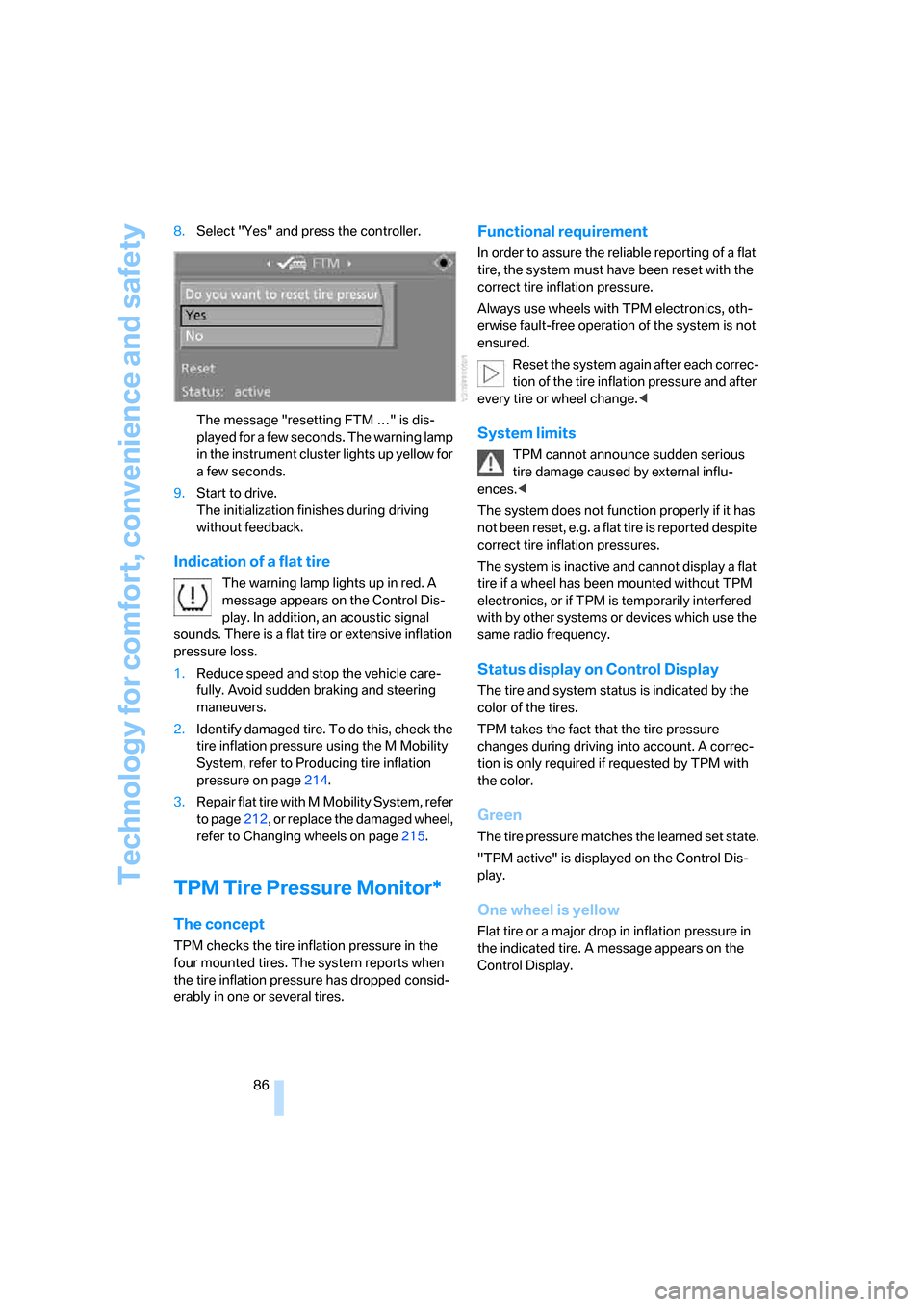
Technology for comfort, convenience and safety
86 8.Select "Yes" and press the controller.
The message "resetting FTM …" is dis-
played for a few seconds. The warning lamp
in the instrument cluster lights up yellow for
a few seconds.
9.Start to drive.
The initialization finishes during driving
without feedback.
Indication of a flat tire
The warning lamp lights up in red. A
message appears on the Control Dis-
play. In addition, an acoustic signal
sounds. There is a flat tire or extensive inflation
pressure loss.
1.Reduce speed and stop the vehicle care-
fully. Avoid sudden braking and steering
maneuvers.
2.Identify damaged tire. To do this, check the
tire inflation pressure using the M Mobility
System, refer to Producing tire inflation
pressure on page214.
3.Repair flat tire with M Mobility System, refer
to page212, or replace the damaged wheel,
refer to Changing wheels on page215.
TPM Tire Pressure Monitor*
The concept
TPM checks the tire inflation pressure in the
four mounted tires. The system reports when
the tire inflation pressure has dropped consid-
erably in one or several tires.
Functional requirement
In order to assure the reliable reporting of a flat
tire, the system must have been reset with the
correct tire inflation pressure.
Always use wheels with TPM electronics, oth-
erwise fault-free operation of the system is not
ensured.
Reset the system again after each correc-
tion of the tire inflation pressure and after
every tire or wheel change.<
System limits
TPM cannot announce sudden serious
tire damage caused by external influ-
ences.<
The system does not function properly if it has
not been reset, e.g. a flat tire is reported despite
correct tire inflation pressures.
The system is inactive and cannot display a flat
tire if a wheel has been mounted without TPM
electronics, or if TPM is temporarily interfered
with by other systems or devices which use the
same radio frequency.
Status display on Control Display
The tire and system status is indicated by the
color of the tires.
TPM takes the fact that the tire pressure
changes during driving into account. A correc-
tion is only required if requested by TPM with
the color.
Green
The tire pressure matches the learned set state.
"TPM active" is displayed on the Control Dis-
play.
One wheel is yellow
Flat tire or a major drop in inflation pressure in
the indicated tire. A message appears on the
Control Display.
Page 89 of 256
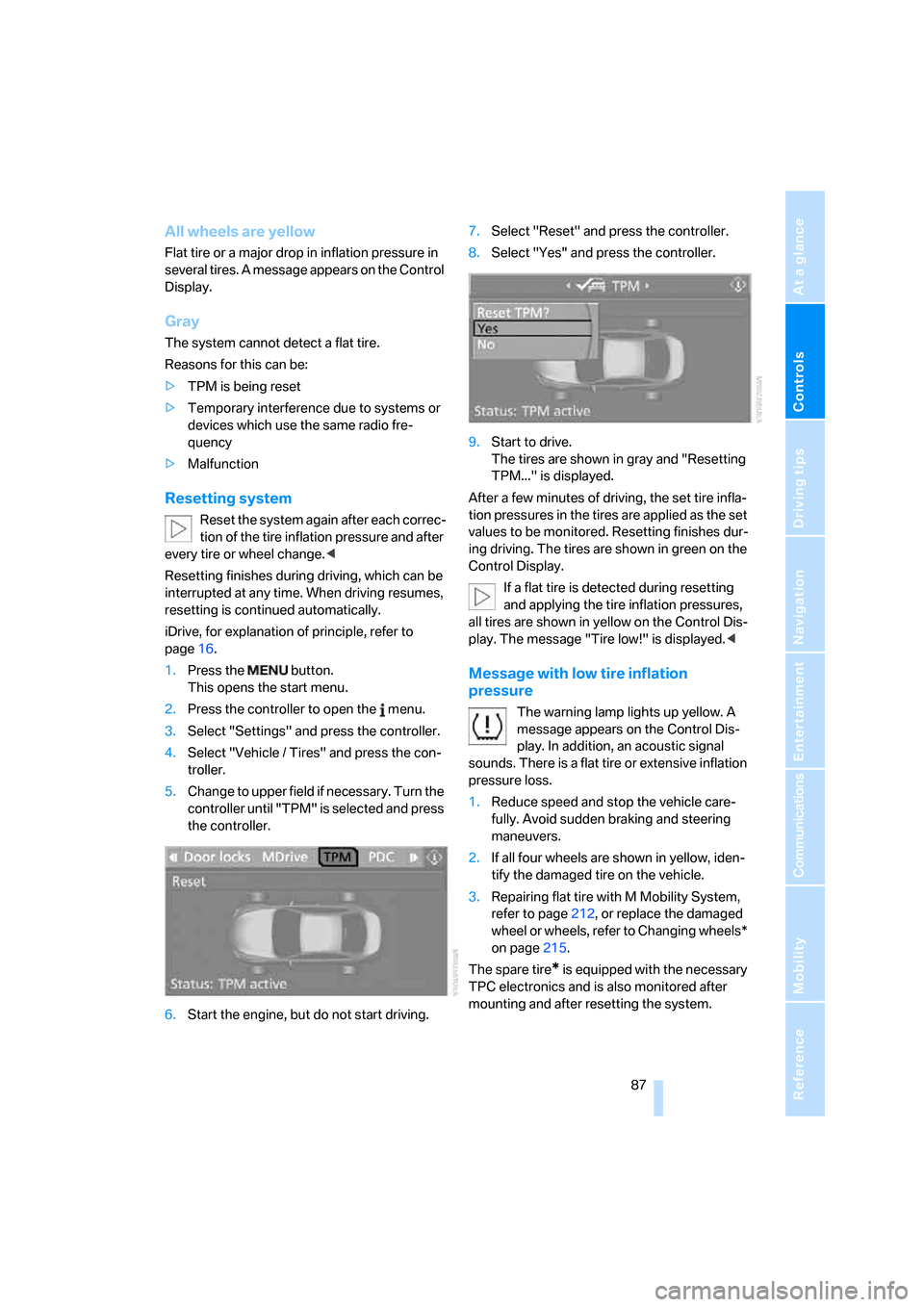
Controls
87Reference
At a glance
Driving tips
Communications
Navigation
Entertainment
Mobility
All wheels are yellow
Flat tire or a major drop in inflation pressure in
several tires. A message appears on the Control
Display.
Gray
The system cannot detect a flat tire.
Reasons for this can be:
>TPM is being reset
>Temporary interference due to systems or
devices which use the same radio fre-
quency
>Malfunction
Resetting system
Reset the system again after each correc-
tion of the tire inflation pressure and after
every tire or wheel change.<
Resetting finishes during driving, which can be
interrupted at any time. When driving resumes,
resetting is continued automatically.
iDrive, for explanation of principle, refer to
page16.
1.Press the button.
This opens the start menu.
2.Press the controller to open the menu.
3.Select "Settings" and press the controller.
4.Select "Vehicle / Tires" and press the con-
troller.
5.Change to upper field if necessary. Turn the
controller until "TPM" is selected and press
the controller.
6.Start the engine, but do not start driving.7.Select "Reset" and press the controller.
8.Select "Yes" and press the controller.
9.Start to drive.
The tires are shown in gray and "Resetting
TPM..." is displayed.
After a few minutes of driving, the set tire infla-
tion pressures in the tires are applied as the set
values to be monitored. Resetting finishes dur-
ing driving. The tires are shown in green on the
Control Display.
If a flat tire is detected during resetting
and applying the tire inflation pressures,
all tires are shown in yellow on the Control Dis-
play. The message "Tire low!" is displayed.<
Message with low tire inflation
pressure
The warning lamp lights up yellow. A
message appears on the Control Dis-
play. In addition, an acoustic signal
sounds. There is a flat tire or extensive inflation
pressure loss.
1.Reduce speed and stop the vehicle care-
fully. Avoid sudden braking and steering
maneuvers.
2.If all four wheels are shown in yellow, iden-
tify the damaged tire on the vehicle.
3.Repairing flat tire with M Mobility System,
refer to page212, or replace the damaged
wheel or wheels, refer to Changing wheels*
on page215.
The spare tire
* is equipped with the necessary
TPC electronics and is also monitored after
mounting and after resetting the system.
Page 198 of 256
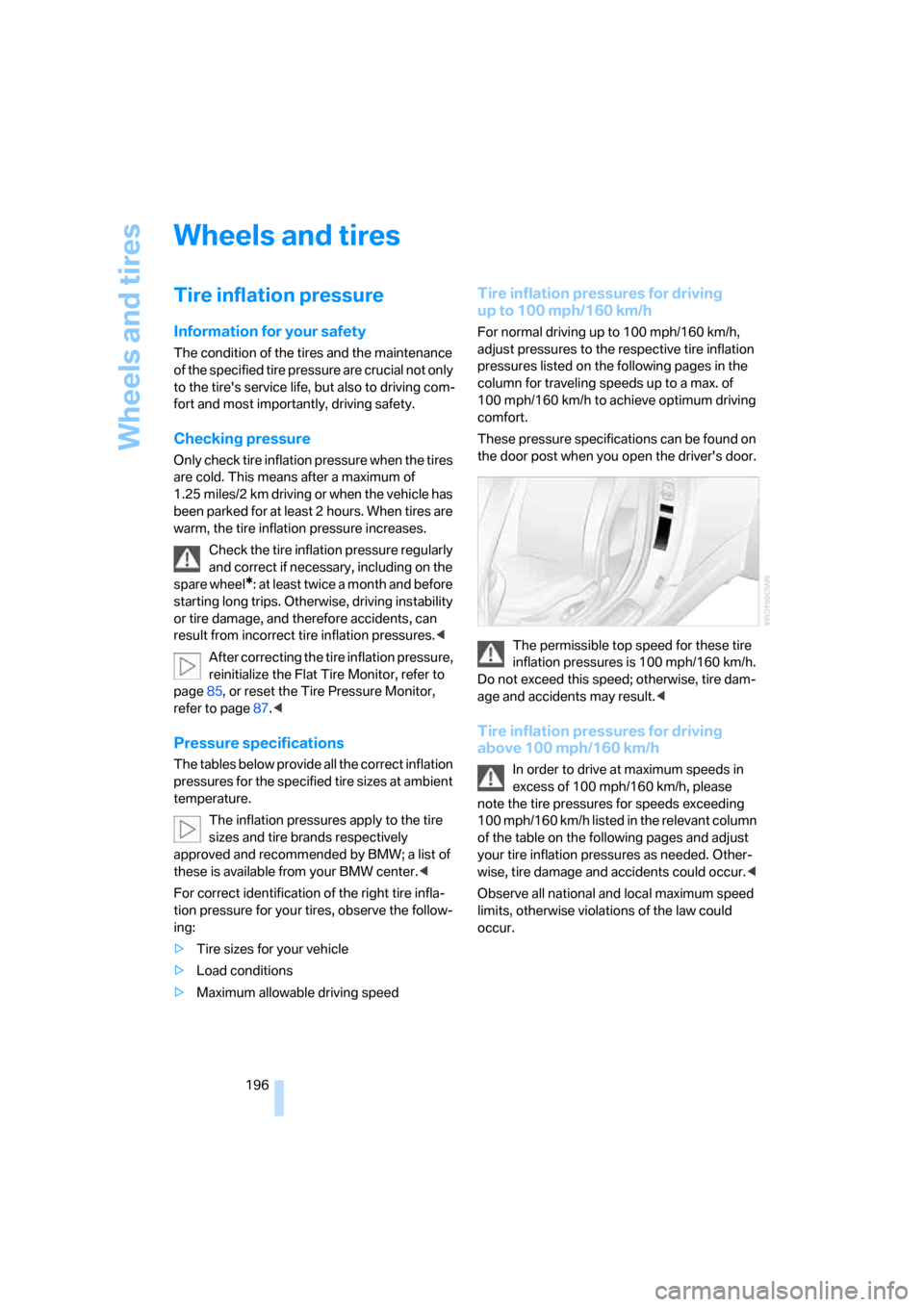
Wheels and tires
196
Wheels and tires
Tire inflation pressure
Information for your safety
The condition of the tires and the maintenance
of the specified tire pressure are crucial not only
to the tire's service life, but also to driving com-
fort and most importantly, driving safety.
Checking pressure
Only check tire inflation pressure when the tires
are cold. This means after a maximum of
1.25 miles/2 km driving or when the vehicle has
been parked for at least 2 hours. When tires are
warm, the tire inflation pressure increases.
Check the tire inflation pressure regularly
and correct if necessary, including on the
spare wheel
*: at least twice a month and before
starting long trips. Otherwise, driving instability
or tire damage, and therefore accidents, can
result from incorrect tire inflation pressures.<
After correcting the tire inflation pressure,
reinitialize the Flat Tire Monitor, refer to
page85, or reset the Tire Pressure Monitor,
refer to page87.<
Pressure specifications
The tables below provide all the correct inflation
pressures for the specified tire sizes at ambient
temperature.
The inflation pressures apply to the tire
sizes and tire brands respectively
approved and recommended by BMW; a list of
these is available from your BMW center.<
For correct identification of the right tire infla-
tion pressure for your tires, observe the follow-
ing:
>Tire sizes for your vehicle
>Load conditions
>Maximum allowable driving speed
Tire inflation pressures for driving
up to 100 mph/160 km/h
For normal driving up to 100 mph/160 km/h,
adjust pressures to the respective tire inflation
pressures listed on the following pages in the
column for traveling speeds up to a max. of
100 mph/160 km/h to achieve optimum driving
comfort.
These pressure specifications can be found on
the door post when you open the driver's door.
The permissible top speed for these tire
inflation pressures is 100 mph/160 km/h.
Do not exceed this speed; otherwise, tire dam-
age and accidents may result.<
Tire inflation pressures for driving
above 100 mph/160 km/h
In order to drive at maximum speeds in
excess of 100 mph/160 km/h, please
note the tire pressures for speeds exceeding
100 mph/160 km/h listed in the relevant column
of the table on the following pages and adjust
your tire inflation pressures as needed. Other-
wise, tire damage and accidents could occur.<
Observe all national and local maximum speed
limits, otherwise violations of the law could
occur.
Page 247 of 256
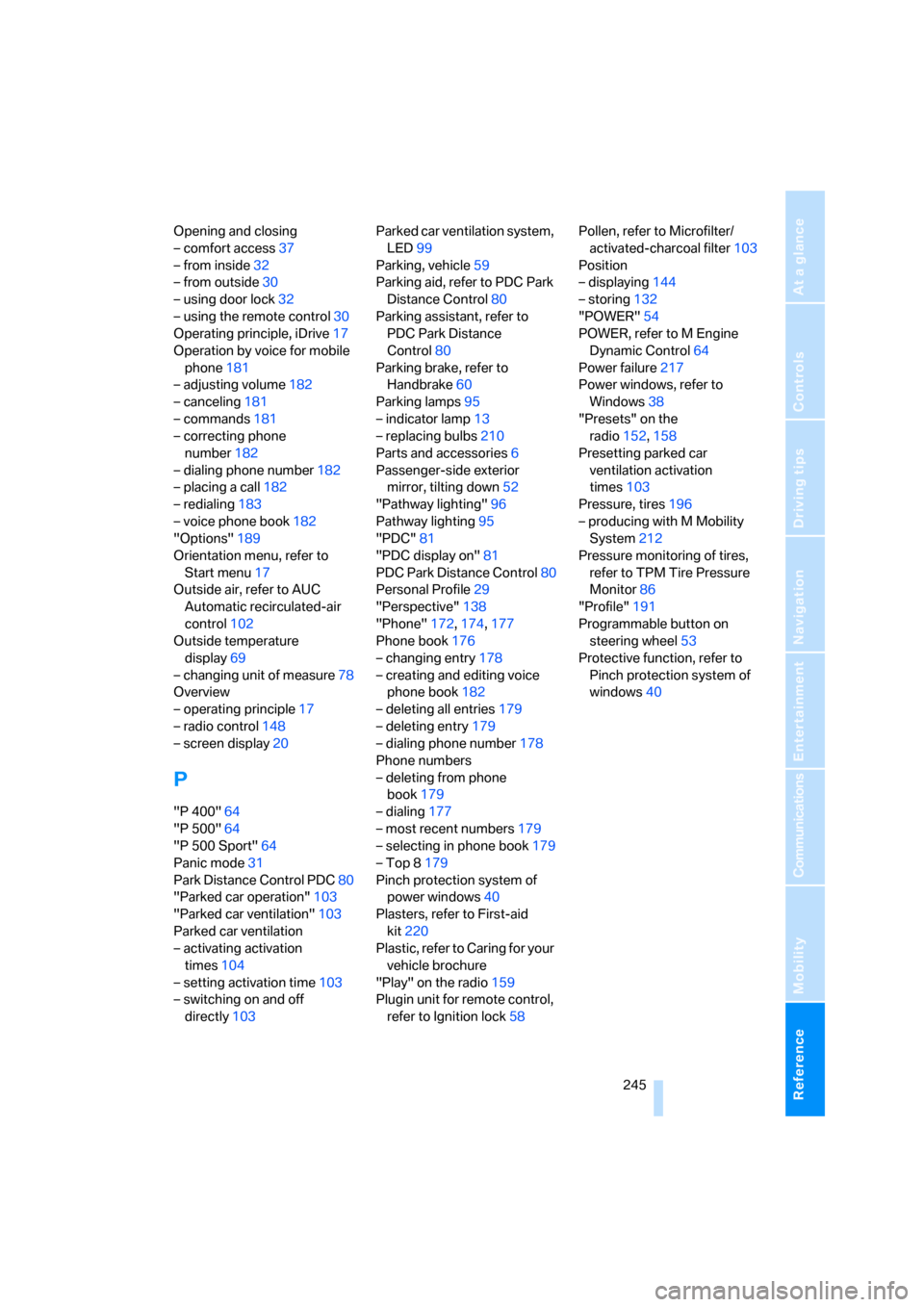
Reference 245
At a glance
Controls
Driving tips
Communications
Navigation
Entertainment
Mobility
Opening and closing
– comfort access37
– from inside32
– from outside30
– using door lock32
– using the remote control30
Operating principle, iDrive17
Operation by voice for mobile
phone181
– adjusting volume182
– canceling181
– commands181
– correcting phone
number182
– dialing phone number182
– placing a call182
– redialing183
– voice phone book182
"Options"189
Orientation menu, refer to
Start menu17
Outside air, refer to AUC
Automatic recirculated-air
control102
Outside temperature
display69
– changing unit of measure78
Overview
– operating principle17
– radio control148
– screen display20
P
"P 400"64
"P 500"64
"P 500 Sport"64
Panic mode31
Park Distance Control PDC80
"Parked car operation"103
"Parked car ventilation"103
Parked car ventilation
– activating activation
times104
– setting activation time103
– switching on and off
directly103Parked car ventilation system,
LED99
Parking, vehicle59
Parking aid, refer to PDC Park
Distance Control80
Parking assistant, refer to
PDC Park Distance
Control80
Parking brake, refer to
Handbrake60
Parking lamps95
– indicator lamp13
– replacing bulbs210
Parts and accessories6
Passenger-side exterior
mirror, tilting down52
"Pathway lighting"96
Pathway lighting95
"PDC"81
"PDC display on"81
PDC Park Distance Control80
Personal Profile29
"Perspective"138
"Phone"172,174,177
Phone book176
– changing entry178
– creating and editing voice
phone book182
– deleting all entries179
– deleting entry179
– dialing phone number178
Phone numbers
– deleting from phone
book179
– dialing177
– most recent numbers179
– selecting in phone book179
– Top 8179
Pinch protection system of
power windows40
Plasters, refer to First-aid
kit220
Plastic, refer to Caring for your
vehicle brochure
"Play" on the radio159
Plugin unit for remote control,
refer to Ignition lock58Pollen, refer to Microfilter/
activated-charcoal filter103
Position
– displaying144
– storing132
"POWER"54
POWER, refer to M Engine
Dynamic Control64
Power failure217
Power windows, refer to
Windows38
"Presets" on the
radio152,158
Presetting parked car
ventilation activation
times103
Pressure, tires196
– producing with M Mobility
System212
Pressure monitoring of tires,
refer to TPM Tire Pressure
Monitor86
"Profile"191
Programmable button on
steering wheel53
Protective function, refer to
Pinch protection system of
windows40
Page 252 of 256
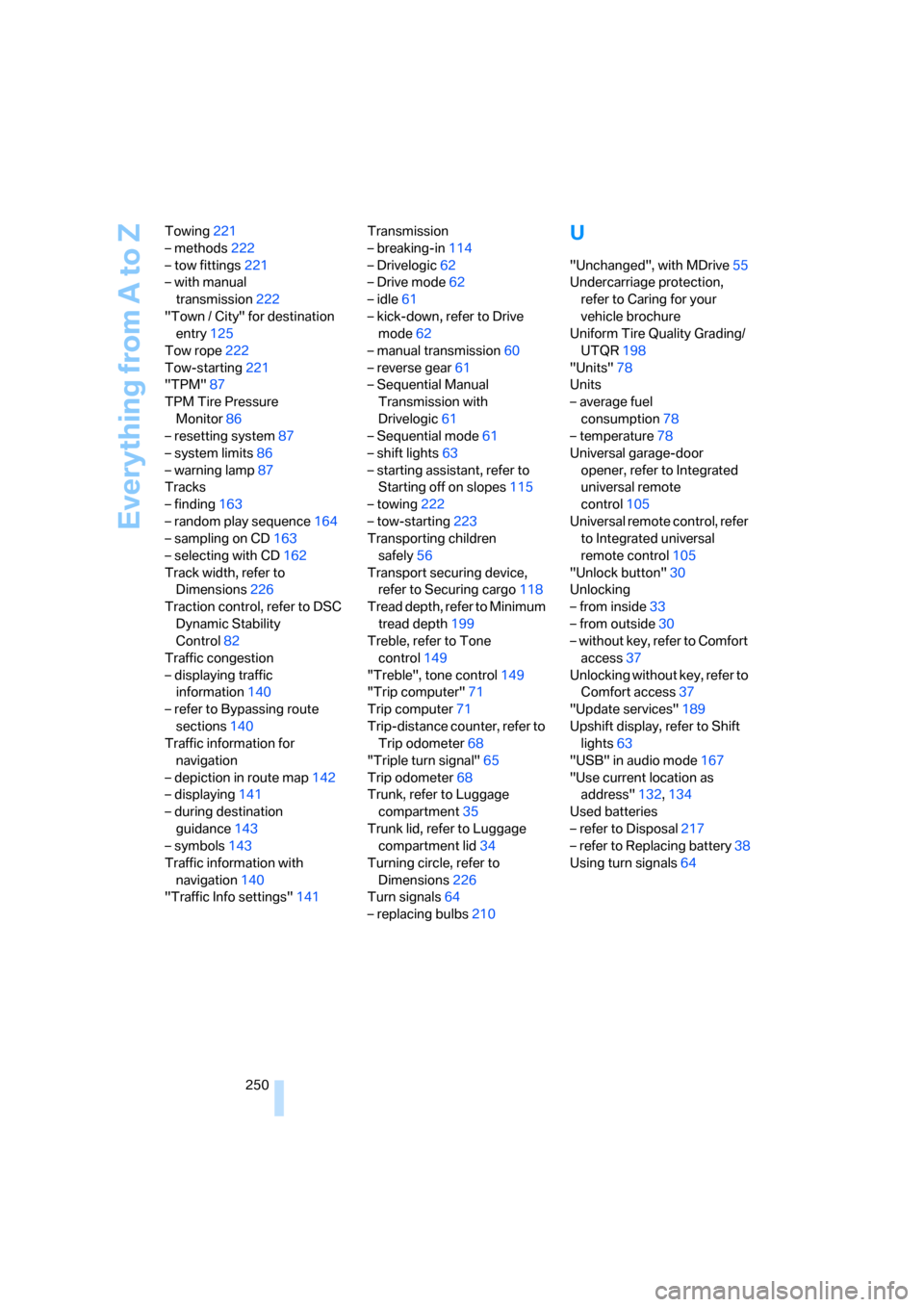
Everything from A to Z
250 Towing221
– methods222
– tow fittings221
– with manual
transmission222
"Town / City" for destination
entry125
Tow rope222
Tow-starting221
"TPM"87
TPM Tire Pressure
Monitor86
– resetting system87
– system limits86
– warning lamp87
Tracks
– finding163
– random play sequence164
– sampling on CD163
– selecting with CD162
Track width, refer to
Dimensions226
Traction control, refer to DSC
Dynamic Stability
Control82
Traffic congestion
– displaying traffic
information140
– refer to Bypassing route
sections140
Traffic information for
navigation
– depiction in route map142
– displaying141
– during destination
guidance143
– symbols143
Traffic information with
navigation140
"Traffic Info settings"141Transmission
– breaking-in114
– Drivelogic62
– Drive mode62
– idle61
– kick-down, refer to Drive
mode62
– manual transmission60
– reverse gear61
– Sequential Manual
Transmission with
Drivelogic61
– Sequential mode61
– shift lights63
– starting assistant, refer to
Starting off on slopes115
– towing222
– tow-starting223
Transporting children
safely56
Transport securing device,
refer to Securing cargo
118
Tread depth, refer to Minimum
tread depth199
Treble, refer to Tone
control149
"Treble", tone control149
"Trip computer"71
Trip computer71
Trip-distance counter, refer to
Trip odometer68
"Triple turn signal"65
Trip odometer68
Trunk, refer to Luggage
compartment35
Trunk lid, refer to Luggage
compartment lid34
Turning circle, refer to
Dimensions226
Turn signals64
– replacing bulbs210
U
"Unchanged", with MDrive55
Undercarriage protection,
refer to Caring for your
vehicle brochure
Uniform Tire Quality Grading/
UTQR198
"Units"78
Units
– average fuel
consumption78
– temperature78
Universal garage-door
opener, refer to Integrated
universal remote
control105
Universal remote control, refer
to Integrated universal
remote control105
"Unlock button"30
Unlocking
– from inside33
– from outside30
– without key, refer to Comfort
access37
Unlocking without key, refer to
Comfort access37
"Update services"189
Upshift display, refer to Shift
lights63
"USB" in audio mode167
"Use current location as
address"132,134
Used batteries
– refer to Disposal217
– refer to Replacing battery38
Using turn signals64